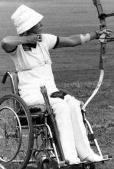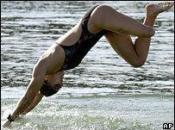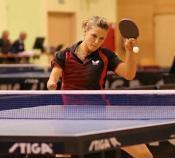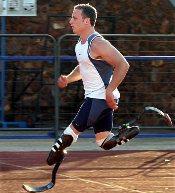To continue our Olympic series, we now discuss the triumphs of athletes we don’t expect to see in world-class sporting events normally participated in by able-bodied athletes.
As discussed previously, propulsion is a big no-no[1] in Olympic competitions. Because these athletes compete without mechanisms that give them advantage over their competitors, they qualified to compete in the Olympics (they may also have qualified to compete in the Paralympics but that’s another matter).
For most of these athletes, there was no legal case filed questioning their qualifications since most of them competed without any artificial limb. The one case filed and discussed later below is a landmark case. It is just unfortunate that the athlete involved was not able to qualify for the Beijing Games due to a slow running time.
George Eyser (1871-?)
The pioneer for all disabled Olympians is U.S. gymnast George Eyser[2] who competed with a wooden left leg in St. Louis 1904 where he won 3 golds, 2 silvers and 1 bronze. He had his leg amputated after a train ran over it.
Neroli Fairhall (1944- 2006)
The pioneer for paraplegic Olympians is New Zealand archer Neroli Fairhall[3] who competed in Los Angeles 1984. She took up archery only after becoming paralyzed from the waist down due to a motorbike accident. There were questions on the possible advantage her wheelchair provided as support but nothing became of them.
Marla Runyan (1969- )
At 9, Marla Runyan was diagnosed with Stargardt’s disease which causes legal blindness. Eventually, her vision deteriorated thus classifying her as legally blind. Regardless, she competed in track and field and won the 100m, 200m, 400m and long jump in the 1992 Barcelona Paralympics, and the Pentathlon in the Atlanta 1996 Paralympics.[4] She qualified for and competed in Sydney 2000 in the 1500m and in Athens 2004 in the 5000m race.[5]
Natalie du Toit (1984- )
At 16, South African swimmer Natalie du Toit[6] was already an internationally competitive swimmer - having nearly qualified for Sydney 2000. In 2001, however, a careless driver directly ran into her left leg causing it to be amputated. She continued swimming and competed in the Paralympic Games in Athens 2004. Now at 24, she qualifies for the 1st time to compete in the Summer Olympics, albeit 1 leg short. She will compete in open water in the Women’s Marathon 10km in Beijing.
Natalia Partyka (1989 - )
Polish pingpong player Natalia Partyka[7] was born without a right forearm. Like Natalie Du Toit, she competes without any prosthetic. She has already competed twice in the Paralympic Games, in Sydney 2000 and Athens 2004. This year, both she and Natalie will compete in the Beijing Summer and Paralympic Games.
Oscar Pistorius (1986- )
Now on to the landmark case involving South African runner Oscar Pistorius and his artificial limbs called the Cheetah Flex-Foot (made by the Icelandic company Össur).[8] As backgrounder, Mr. Pistorius (aptly nicknamed the Bladerunner) was born with no calf bones nor ankles, and just two toes on each foot.[9] His parents eventually decided to have his legs amputated below the knees before his 1st birthday.
Though already very active in sports from an early age, he only took up sprinting when he injured his knee playing rugby in 2004. In the same year, he won gold in the 200m and bronze in the 100m races in the Athens Paralympics.
Also in 2004, he began to compete with able-bodied runners and began receiving invitations to compete in events sanctioned by the International Association of Athletics Federations (IAAF).
In 2007, the IAAF amended its rule on the use of technical devices which now reads and prohibits as follows:
“Use of any technical device that incorporates springs, wheels or any other element that provides the user with an advantage over another athlete not using such a device.” (IAAF Rule 144.2(e))Also in 2007, and armed with high definition cameras, the IAAF videotaped Mr. Pistorius’ run in a Rome race. Months later, Mr. Pistorious participated in IAAF-sponsored biomechanical tests to determine if his prosthesis really gave him an advantage (contrary to the rule). The tests were made to evaluate his sprint movement, oxygen intake and blood lactate metabolism (together with 5 other “control” athletes).
Based on the tests, the IAAF ruled that there was indeed a violation of the rule because the tests showed that Mr. Pistorius gained advantages from the use of his prosthesis.
Mr. Pistorius then filed an appeal with the Court of Arbitration for Sport (CAS). In interpreting Rule 144.2 (e), the CAS determined that the ‘advantage’ the rule speaks of can only mean an “overall net advantage” because if the device is found to provide both advantages and disadvantages yet the disadvantages outnumber the advantages, the athlete is competing with an overall net disadvantage and, therefore, not in violation of the rule.
The CAS found that since the tests were only designed to find advantages and were not intended to discover disadvantages, the IAAF failed to prove that there was a violation of the rule as the tests failed to show if there was an overall net advantage or disadvantage.
In addition, the CAS ruled that the IAAF was not able to provide sufficient proof of actual advantages that: (1) the Cheetah Flex-Foot provides any metabolic advantage; (2) that the biomechanical effects of using it gave Mr. Pistorius an advantage over his competitors who don’t use it; or (3) its use acts more, or less, than a human ankle or lower leg in terms of spring-like quality.
The CAS also took note of the 10-year existence of the Cheetah Flex-Foot during which its use by other runners has not resulted in the ability of the latter to run competitively against able-bodied runners as Mr. Pistorius has.
In upholding Mr. Pistorius’ appeal, however, the CAS carefully noted that their decision does not: (1) apply to any future development of the Cheetah Flex-Foot; (2) preclude the possibility that the IAAF will someday be able to prove it that the device does violate the rule; nor (3) apply to any other athlete or any other prosthetic.
It would have been awesome to have seen the Bladerunner run in the Olympics, especially for other disabled athletes. But the decision is groundbreaking enough as to give athletes with prosthetics more hope in being able to compete against able-bodied athletes in the near future.
Certainly, the presence of Natalie du Toit and Natalia Partyka in the Beijing Games provide more than enough awe and inspiration to anyone.
[1] “The Modern Olympic Games”. http://www.olympic.org. 2007. International Olympic Committee. 29 July 2008 http://multimedia.olympic.org/pdf/en_report_668.pdf.
[2] “George Eyser”. www.databaseolympics.com. August 12, 2008 http://www.databaseolympics.com/players/playerpage.htm?ilkid=EYSERGEO01.
[3] “Neroli Fairhall”. www.beijing2008.cn. 2008. Beijing 2008 Olympic Games. 12 August 2008 http://en.beijing2008.cn/spirit/pastgames/halloffame/f/n214044766.shtml.
[4] “Ouch ! — its a disability thing”. www.bbc.co.uk. 15 August 2008. BBC. 15 August 2008 http://www.bbc.co.uk/ouch/paralympics/facts/.
[5] “Biography”. www.marlarunyan.com. 15 August 2008 http://www.marlarunyan.com/biography.php
[6] “Natalie’s Story”. www.nataliedutoit.com. 2006. 15 August 2008 http://www.nataliedutoit.com/?q=node/3
[7] Chang, Anita. “Polish teen to compete in Olympics and Paralympics”. www.suntimes.com. 10 Aug 2008. Chicago Sun-Times. 12 Aug 2008 http://stats.suntimes.com/olympics/story.asp?i=20080810102837687989008.
[8] Oscar Pistorius v. International Association of Athletics Federations, CAS 2008/A/1480, 16 May 2008.
[9] Draper, Rob. “The fastest man on no legs now has the Olympics in his sights”. www.dailymail.co.uk 7 Jul 2007. Daily Mail. 12 August 2008 http://www.dailymail.co.uk/news/article-466904/The-fastest-man-legs-Olympics-sights.html





No comments:
Post a Comment